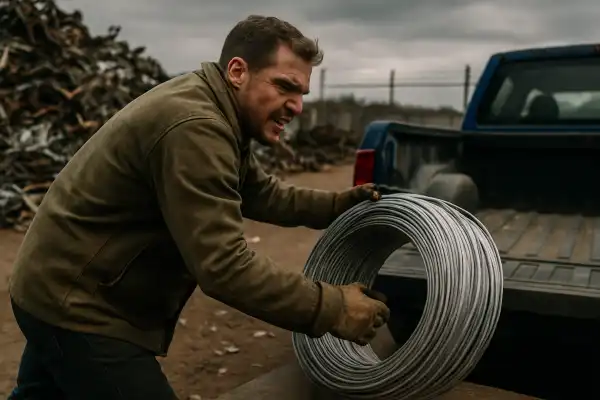What items are considered scrap metal? This question crosses my desk regularly from both industry professionals and newcomers to the recycling game. Understanding which materials qualify as scrap metal can unlock significant value from items you might otherwise overlook.
During my early days transitioning from mechanical engineering to sustainability writing, I discovered that most people dramatically underestimate the scrap metal potential hiding in plain sight around their homes and workplaces. The metal recycling industry generated over $64 billion in 2020, with much of this value coming from materials people initially considered “junk”.
What items are considered scrap metal?
Scrap metal is anything that is at least 80% metal, regardless of the specific type. The items fall into two primary categories: ferrous metals (containing iron) and non-ferrous metals (without iron). You can easily distinguish between these categories using a simple magnet test – if your object is magnetic, it’s ferrous metal, and if it’s non-magnetic, it’s non-ferrous.

Ferrous metal items
Ferrous metals contain iron, making them magnetic and highly durable. These represent the most recycled materials globally, though they typically command lower prices than non-ferrous alternatives due to abundant supply.
Kitchen appliances and cookware form a substantial category. Refrigerators, ovens, microwaves, dishwashers, and cast iron skillets all qualify as ferrous scrap. These bulky appliances can be worth a significant amount due to their weight in scrap metal. Cast iron pots and pans, particularly when you remove plastic or rubber handles, fetch better prices.
Automotive components represent another major source. Old car parts or entire vehicles qualify, though you must drain all fluids and separate ferrous from non-ferrous components for optimal value. Engine blocks, body panels, and structural components all contain substantial amounts of recyclable steel and iron.
Structural and construction materials include pipes, plumbing fixtures, and steel beams. Iron railings, swing sets, and outdoor furniture commonly made of iron also qualify. Exercise equipment, lawn furniture, nails, nuts and bolts, bottle caps, and wire all contain recyclable ferrous metals.
Tools and hardware round out this category. Old power tools, hand tools, and metal storage solutions all contain ferrous metals worth recycling.
Non-ferrous metal items
Non-ferrous metals include aluminum, brass, copper, nickel, tin, lead, and zinc, as well as precious metals like gold and silver. These materials command higher prices due to their superior properties and limited supply.
Aluminum items are among the most valuable and common. Soda cans, food wrap foils, screen doors, window screens, and aluminum wiring from air conditioning units and old mobile homes all qualify. Aluminum patio chairs and outdoor furniture, when you remove plastic components, provide substantial value despite aluminum’s lightweight nature.
Copper materials offer exceptional value. Copper pipes, tubing, electrical wiring, roofing materials, and HVAC systems contain this highly conductive metal. Power outlet bars and electric transformers from old electronics typically contain “copper bearing” materials. Copper has a reddish color when in good condition but can appear dark brown when worn.
Brass components frequently appear in household fixtures. Doorknobs, cookware, bed frames, and sink faucets often contain brass. Red brass contains 85-90% copper and is commonly found in plumbing fixtures, valves, and bearings, while yellow brass contains 60-70% copper and appears in musical instruments and decorative items.
Stainless steel items bridge ferrous and non-ferrous categories. Stainless steel sinks qualify for recycling, though you should ensure they’re purely steel without other materials that could reduce value.
Electronic waste (e-waste)
Electronic waste represents a complex mix of plastics and metals, containing both base and precious metals. Desktop computers and laptops contain copper wires and valuable components like motherboards. Ceiling fan motors contain electric coils with substantial copper amounts, and older televisions may contain copper yokes.
Old electronics such as computers, televisions, and cell phones contain various metals including aluminum, copper, and gold. However, some electronics like CRT televisions and monitors require special handling fees due to hazardous materials.
Specialty items and materials
Lead-based items require careful handling due to toxicity. Lead requires so much energy to mine that manufacturers prefer purchasing recycled lead, making it valuable despite handling concerns. Old car batteries and some plumbing components contain lead.
Tin materials include tin-coated scrap commonly found in tin cans and food containers, plus tin foil scrap from household items.
Precious metals appear in specialized applications. Titanium appears in jewelry, aerospace applications, and medical equipment, making it extremely valuable. Nickel commonly appears in batteries and electronics production.
Items to avoid
Non-metallic items like concrete, wood, asphalt, dirt, debris, and excessive tires (more than 5 per automobile) don’t qualify as scrap metal. Contaminated materials or those mixed with substantial non-metal components may reduce value or face rejection.
Conclusion
Recycling scrap metal provides environmental benefits by reducing the need for mining virgin materials while offering economic returns. For example, recycling steel conserves 2,500 pounds of iron ore, 1,400 pounds of coal, and 120 pounds of limestone per ton.
In January, I helped a neighbor clean out his garage before moving. Among the “junk” we sorted through, we identified over 200 pounds of mixed metals: old car parts, copper piping from a bathroom renovation, aluminum storm doors, and various tools. That afternoon’s work netted him nearly $300 – not bad for materials he was planning to trash. More importantly, we kept valuable resources from the landfill while supporting the circular economy that has defined my career in sustainable metalworking.
